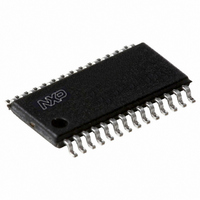SC16IS752IPW,112 NXP Semiconductors, SC16IS752IPW,112 Datasheet - Page 33

SC16IS752IPW,112
Manufacturer Part Number
SC16IS752IPW,112
Description
IC UART DUAL 12C/SPI 28TSSOP
Manufacturer
NXP Semiconductors
Type
IrDA or RS- 232 or RS- 485r
Datasheet
1.SC16IS752IBS151.pdf
(59 pages)
Specifications of SC16IS752IPW,112
Number Of Channels
2, DUART
Package / Case
28-TSSOP (0.173", 4.40mm Width)
Features
Low Current
Fifo's
64 Byte
Protocol
RS232, RS485
Voltage - Supply
2.5V, 3.3V
With Auto Flow Control
Yes
With Irda Encoder/decoder
Yes
With False Start Bit Detection
Yes
With Modem Control
Yes
Mounting Type
Surface Mount
Data Rate
5 Mbps
Supply Voltage (max)
3.6 V
Supply Voltage (min)
2.3 V
Supply Current
6 mA
Maximum Operating Temperature
+ 95 C
Minimum Operating Temperature
- 40 C
Mounting Style
SMD/SMT
Operating Supply Voltage
2.5 V or 3.3 V
Lead Free Status / RoHS Status
Lead free / RoHS Compliant
For Use With
568-4000 - DEMO BOARD SPI/I2C TO DUAL UART568-3510 - DEMO BOARD SPI/I2C TO UART
Lead Free Status / Rohs Status
Lead free / RoHS Compliant
Other names
568-4016-5
935279292112
SC16IS752IPW
SC16IS752IPW
935279292112
SC16IS752IPW
SC16IS752IPW
NXP Semiconductors
9. RS-485 features
SC16IS752_SC16IS762_7
Product data sheet
8.21 Enhanced Features Register (EFR)
9.1 Auto RS-485 RTS control
9.2 RS-485 RTS output inversion
This 8-bit register enables or disables the enhanced features of the UART.
the Enhanced Features Register bit settings.
Table 31.
Normally the RTS pin is controlled by MCR bit 1, or if hardware flow control is enabled, the
logic state of the RTS pin is controlled by the hardware flow control circuitry. EFCR
register bit 4 will take the precedence over the other two modes; once this bit is set, the
transmitter will control the state of the RTS pin. The transmitter automatically asserts the
RTS pin (logic 0) once the host writes data to the transmit FIFO, and deasserts RTS pin
(logic 1) once the last bit of the data has been transmitted.
To use the auto RS-485 RTS mode the software would have to disable the hardware flow
control function.
EFCR bit 5 reverses the polarity of the RTS pin if the UART is in auto RS-485 RTS mode.
When the transmitter has data to be sent it deasserts the RTS pin (logic 1), and when the
last bit of the data has been sent out the transmitter asserts the RTS pin (logic 0).
Bit
7
6
5
4
3:0
Symbol
EFR[7]
EFR[6]
EFR[5]
EFR[4]
EFR[3:0]
Enhanced Features Register bits description
Dual UART with I
Description
CTS flow control enable.
RTS flow control enable.
Special character detect.
Enhanced functions enable bit.
Combinations of software flow control can be selected by programming
these bits. See
Rev. 07 — 19 May 2008
logic 0 = CTS flow control is disabled (normal default condition)
logic 1 = CTS flow control is enabled. Transmission will stop when a
HIGH signal is detected on the CTS pin.
logic 0 = RTS flow control is disabled (normal default condition)
logic 1 = RTS flow control is enabled. The RTS pin goes HIGH when
the receiver FIFO halt trigger level TCR[3:0] is reached, and goes
LOW when the receiver FIFO resume transmission trigger level
TCR[7:4] is reached.
logic 0 = special character detect disabled (normal default condition)
logic 1 = special character detect enabled. Received data is compared
with Xoff2 data. If a match occurs, the received data is transferred to
FIFO and IIR[4] is set to a logical 1 to indicate a special character has
been detected.
logic 0 = disables enhanced functions and writing to IER[7:4],
FCR[5:4], MCR[7:5].
logic 1 = enables the enhanced function IER[7:4], FCR[5:4], and
MCR[7:5] so that they can be modified.
Table 3 “Software flow control options
2
SC16IS752/SC16IS762
C-bus/SPI interface, 64-byte FIFOs, IrDA SIR
© NXP B.V. 2008. All rights reserved.
(EFR[3:0])”.
Table 31
shows
33 of 59















